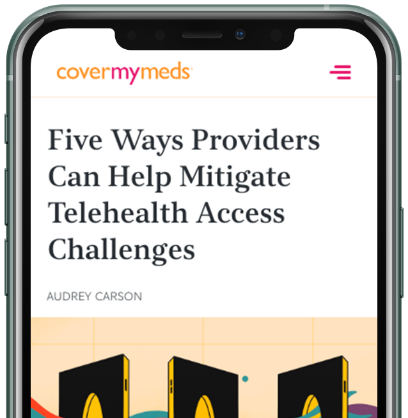Clearing the Path to Medication Access with Technology
While the healthcare industry aims to improve patients’ lives, some healthcare workers interact more directly with patients than others. These individuals were truly essential in 2020, a year marked by the COVID-19 pandemic. Solutions built with the patient in mind aim to make healthcare heroes’ lives easier.

Frontline healthcare workers have gone above and beyond the call of duty during the COVID-19 pandemic — from those directly working with COVID-19 patients to others keeping patients healthy through primary care visits, chronic condition management and acute treatment.
While not everyone is on the front lines, those in the healthcare industry rely on their strengths to help patients live healthier lives. For some, that means developing technology solutions to improve workflows which alleviate inefficient tasks for those working directly with patients every day.
“There are still so many unmet needs in the healthcare arena as it relates to understanding, access to care and to treatment and compliance that have yet to be addressed,” as one nurse practitioner reports.CoverMyMeds Provider Survey, 2020
While 82 percent of providers in our 2020 survey said at least some of their patients asked about ways to save money on their medications, over 40 percent of providers said they do not have the time they need to discuss medications with their patients.CoverMyMeds Provider Survey, 2020
Patient-centered healthcare technology solutions help lift barriers at each step of the medication access journey. They inform medication conversations between patients and providers, support prescribing decisions and create efficiencies for all stakeholders on the patient care team. By addressing medication affordability, access and adherence barriers with technology, payers, pharmacists, providers and pharmaceutical manufacturers can take action to help patients manage their medications.
Here, we examine those trends and some of the technology solutions driving them. Check out the full 2021 Medication Access Report.
Promoting Affordability by Addressing Individual Barriers
In 2020, millions lost their jobs due to the COVID-19-triggered economic downturn. With their jobs went many people’s main source of income and, for nearly half of the unemployed, their health insurance, too.Health Insurance Coverage of the Total Population, Kaiser Family Foundation, 2020 In our most recent patient survey, 65 percent experienced reduced income, became unemployed or lost healthcare coverage due to the COVID-19 pandemic.CoverMyMeds Patient Survey, 2020 This year, nearly 10 percent more patients said they would abandon their prescription medication if it cost more than they expected, compared to 2019.CoverMyMeds Patient Survey, 2019,CoverMyMeds Patient Survey, 2020
For some, this financial and health coverage instability is a new and difficult challenge. Others previously of lower socioeconomic status have trouble securing good jobs, education opportunities and ideal housing. Those who may have always had trouble accessing healthcare and medications can benefit from reliable, go-to affordability options. Sixty-two percent of patients said they actively ask their provider about medication price and affordability options.CoverMyMeds Patient Survey, 2020
Widespread affordability challenges present unique opportunities for providers to initiate conversations with patients around social determinants of health. These conversations help providers better understand what’s financially feasible for their patient, and what other resources they may need access to. Prescription decision support solutions like real-time prescription benefit (RTPB) surface prescription cost, remaining deductible, formulary alternatives, cash price and cost savings programs at the point of prescribing — which drive affordability conversations between patients and their providers.
With this information at hand, providers help patients head off potential barriers before they come up, clearing a patient’s path to medication pickup at the pharmacy.
In one study, patients were 19 percent more adherent to picking up their medication when providers used a prescription decision support solution like RTPB.CoverMyMeds data on file, 2019
Simplifying Through Automation
Even when patients and care team members find affordable options for patients to access their medications, benefit barriers such as prior authorization (PA) are often unavoidable. Integrated technology solutions at the pharmacy and provider’s office can help save time managing PA so patients get the medications they need faster. Electronic prior authorization (ePA) solutions replace manual phone and fax processes, and improve time to therapy.

In our 2020 provider survey, we found a 16 percent increase in ePA adoption and a 12 percent drop in those solely using phone and fax methods compared to 2019.CoverMyMeds Provider Survey, 2020, CoverMyMeds Provider Survey, 2019 It could be that the COVID-19 pandemic forced some of this electronic adoption, as many shifted to remote work.
While ePA portals and websites are a first step to help reduce time and burden from manually submitting PA requests, integrated ePA technology within EHRs can allow providers to submit PA requests earlier, at the point of prescribing. Patients can get their medications an average of 13.2 days sooner when providers submit PA requests prospectively (at the point of prescribing) compared to requests started retrospectively (at the pharmacy) after an insurance claim rejection.CoverMyMeds data on file, 2018
Still, fewer than one in five providers start PA requests at the point of prescribing.CoverMyMeds Provider Survey, 2020 Much of the PA request process resides with the pharmacy, where solutions may exist, but integrations are sorely needed.
Having to go to multiple places just to find out what medications an insurance will cover is frustrating for professionals, so I can only imagine how frustrating it is for patients.
PharmacistCoverMyMeds Pharmacist Survey, 2020
Pharmacists need robust solutions to resolve patient access barriers and questions. While many pharmacy tools exist, they don’t always have the capabilities needed to best serve patients in one system. Only a third of pharmacists receive PA status updates within their current system, and 43 percent said they go outside their system daily to complete tasks, including PA request management.CoverMyMeds Pharmacist Survey, 2020 Pharmacists using an integrated solution, including real-time PA status updates, saw a 14 percent increase in paid claims, on average.CoverMyMeds data on file, 2018

Supporting Adherence by Crisis-Proofing Chronic Conditions
Patients with complex conditions requiring specialty medications often face high cost and challenging paths to medication access. For these reasons, they’re more likely to abandon specialty therapies than any other drugs during the deductible period.Medicine Use and Spending in the U.S., A Review of 2016 and Outlook to 2021, IQVIA, 2017 However, electronic patient support services can bridge barrier gaps to improve patient adherence. These programs are a balm for patients who often become frustrated with keeping up with medical records, various appointments and lab results.
With electronic patient support services, providers can electronically enroll patients in specialty hubs, helping expedite benefit verification, PA processes and expedited access to specialty pharmacies. Such patient support services have contributed to a 34 percent reduction in time to therapy in some cases.
Healthcare solutions are helping providers and pharmacists address medication access issues for patients. Find out how in the 2021 Medication Access Report.
The latest healthcare insights, floated right to your inbox.





